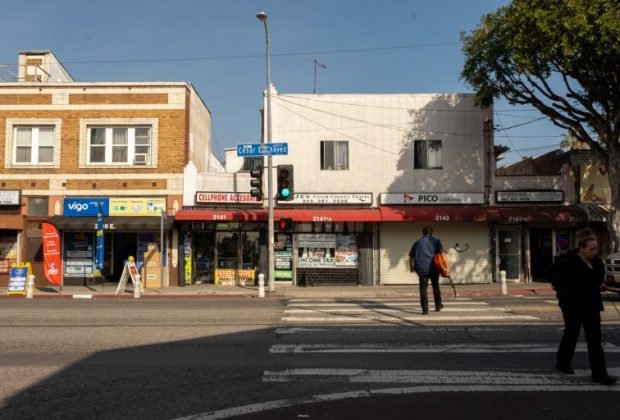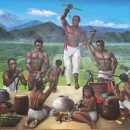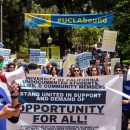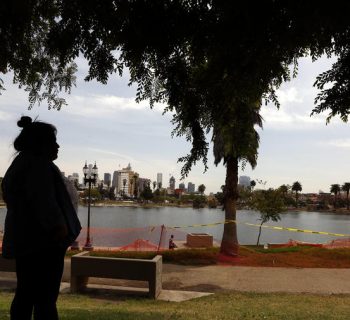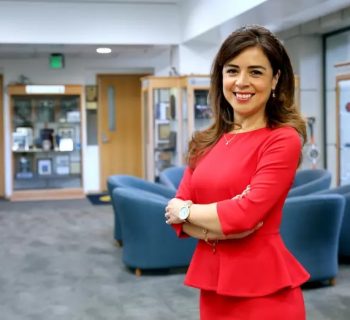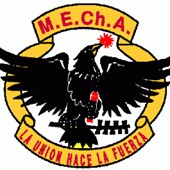Intended for the historic César Chávez corridor, the project dubbed XOLA is being developed by local investors
By Carmen Gonzalez | Boyle Heights Beat | Jan. 18, 2024 | Photo By Andrew Lopez
A couple of storefronts away from the controversial Tiao Properties development on the historic César Chávez corridor, a new building project aims to be received differently by Boyle Heights residents.
A group of local investors is proposing to raze several existing structures between 2141 and 2145 E. Cesar Chavez Avenue, including a small commercial and residential building and several small businesses, and to replace them with a 19-unit affordable housing complex. Unlike other mixed-use developments in the area, the project will use its non-residential space to create XOLA, a free museum dedicated to Chicano art and culture.
The project is led by Toledo Capital Development LLC, and it’s a personal endeavor for co-founder Alfred Fraijo Jr., a land use attorney and well-known community activist. As a long-time Boyle Heights resident and a gay Latino, art was where he found a sense of belonging. As a young man he was introduced to ASCO – the East Los Angeles artists’ collective from the 1970’s– and other Chicano art, and fell in love with his heritage.
“That’s really the story behind the museum,” said Fraijo. “It really is intended to be a safe space for people to feel belonging. It’s for us, by us. It’s intended to celebrate our story.”
According to Toledo Capital Development’s application to the city’s Planning Department, the project will be made up of two buildings. Facing Cesar Chavez Avenue at the front, the proposed plans outline a six story, 96-foot-tall structure, which will house the museum.
The back would have a larger 10-story residential building, with a height of 126-feet, accommodating the 19 apartment units. All but one of the units will be designated as affordable housing for moderate- low- and very-low income households.
Artist’s rendering of front view of museum facing César Chavez. Courtesy of Toledo Capital Development LLC
The project will be designed by Tatiana Bilbao, an award winning Mexican architect known for building sustainable, low cost housing in her country. Fraijo feels it’s an honor to have her come into Boyle Heights.
“We don’t just deserve beautiful buildings in downtown or in the West side,” he said. “We need them in Boyle Heights as well.”
Fraijo Jr. said providing affordable housing was a deliberate choice.
“We need spaces for people to create art,” he explained. “We also need spaces for people to live. The housing is really going to be focused on providing options to artists that live in our community.”
Gallerist Julian Bermudez is serving as a consultant on the museum project. Although XOLA does not currently own an art collection, Bermudez hopes the museum will be a hub for all types of artistic expressions.
“There is such a depth and a breadth of creativity [in this community],” said Bermudez. “Most communities don’t get to see it reflected in their neighborhoods.”
“There’s been a whitewashing of our history. Alfred [Freijo] wants to make sure that that history isn’t forgotten, and that this history is ongoing. It’s one of the things that make Chicano/Latino art so profound.”
A six-person board of directors, made up of community leaders, is looking for input about what XOLA should present. The goal for this museum is to both serve as a memory bank and to start producing art once it opens.
The XOLA mixed-use development would be joining a number of housing projects currently happening along the historic Cesar Chavez Avenue corridor. Just East of the XOLA location, two all-affordable housing complexes are being developed by nonprofit Abode Communities. La Veranda and Chavez Gardens are in advanced stages of construction, with one of them due to move in tenants in July.
A different project is the controversial six-story complex by Tiao Properties, slated to bring mostly market rate apartments. The project is currently halted by opposition from residential and business tenants being displaced.
“It’s outsiders making decisions on land use,” said Fraijo, addressing the Tiao project. “That’s why I really believe that if we don’t own our land, we don’t own our businesses. When we don’t own our business we are vulnerable to displacement.“
If approved, the Toledo project would not provide any new parking spaces. Fraijo said there are enough parking spaces in the area to service his building.
“I want to make sure that we are not providing parking for people from other parts of the community,” he said. “It needs to be a walkable space that is accessible to our people.”
“I want to make sure that kiddos that are walking the streets, like I did growing up, see this building and see themselves in it and feel invited.”
There is one hurdle Toledo must overcome before XOLA becomes a reality. In December the City of Los Angeles passed an Interim Control Ordinance (ICO) that temporarily prevents the issuance of demolition permits for older and historic buildings with rent-controlled, or RSO, units. The ICO is meant to stay in place until the city approves a new Boyle Heights Neighborhood Plan, which would ban the demolition of RSO buildings.
It’s unclear if the ICO would affect the Toledo project, but Fraijo said his team is looking into it.
“I believe it is important to distinguish between projects that are seeking to provide affordable housing options for low-income residents like ours, and those without that goal,” he said. “This project will be all affordable housing and include a museum free to the public that promotes Chicano art, history and culture.”

